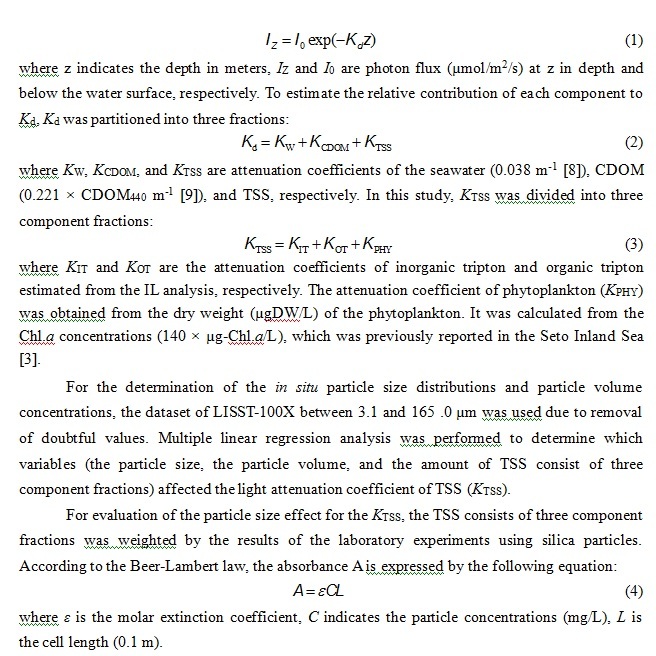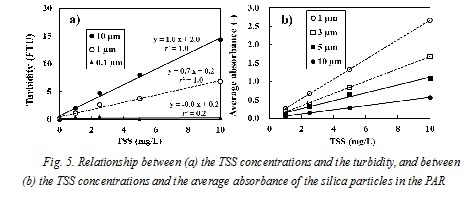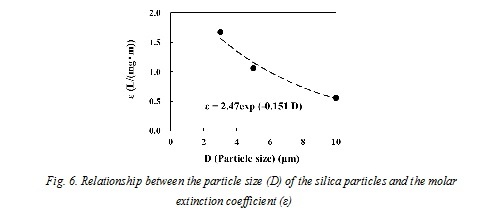BISAC NAT010000 Ecology
BISAC NAT045050 Ecosystems & Habitats / Coastal Regions & Shorelines
BISAC NAT025000 Ecosystems & Habitats / Oceans & Seas
BISAC NAT045030 Ecosystems & Habitats / Polar Regions
BISAC SCI081000 Earth Sciences / Hydrology
BISAC SCI092000 Global Warming & Climate Change
BISAC SCI020000 Life Sciences / Ecology
BISAC SCI039000 Life Sciences / Marine Biology
BISAC SOC053000 Regional Studies
BISAC TEC060000 Marine & Naval
Phytoplankton plays a key role as primary producer, forming the base of marine food webs. Knowledge in relation to permeability of light in water is important for the understanding of phytoplankton growth in the euphotic zone. In this study, we conducted laboratory experiments in relation to light attenuation using inorganic particle (silica particle) and field investigations in Osaka Bay. There was a positive correlation between the concentrations of the silica particle and integral values of the absorbance at photosynthetic active radiation (PAR: wavelength 400-700 nm) in the laboratory experiments. The highest integral value of the absorbance at PAR was observed for the particle size of 1.0 μm. In Osaka Bay, high contribution of the inorganic particle to light attenuation was observed compared to the organic particles. Multiple linear regression analysis using the particle size and the amount of total suspended solids (TSS: consisting of three component fractions; organic/inorganic tripton and phytoplanktons) showed that the particle size was an essential factor controlling the light attenuation in the coastal sea.
light attenuation, CDOM, LISST-100X, Osaka Bay, particle size
I. INTRODUCTION
Riverine supply of inorganic nutrients to estuaries makes these areas of high primary production potential [1]. In shallow areas including estuaries, not only pelagic small organisms representing phytoplanktons but also benthic plants (e.g. seagrasses) and benthic microalgae are principal primary producers. For their photosynthesis, light condition in the water column represented by transparency (Secchi depth) is one of the important factors. The light (PAR) attenuation in the water column was typically divided into the following components: the TSS, chromophoric dissolved organic matter (CDOM), and seawater [2]. The TSS was divided further into three component fractions (inorganic tripton: TSSIT, organic tripton: TSSOT, and phytoplanktons: TSSPHY) [3][4].
Our study area, Seto Inland Sea (area: 23,203 km2) is located in the western part of Japan. In this area, eutrophication occurred during high economic growth period of industrialization and urbanization in the 1950s-70s. Therefore, organic matter and nutrient (nitrogen and phosphorus) loadings have been reduced according to the Water Pollution Control Law (1970) and the Law Concerning Special Measures for Conservation of the Environment of the Seto Inland Sea (1973). Impacts of these control policies were effective, and the transparency in Osaka Bay which was originally a highly eutrophic water area, was dramatically improved. For a better understanding of the light condition supporting primary production, the controlling factor of the transparency in the coastal area needs clarification.
In this study, laboratory experiments in relation to the light attenuation using inorganic particle (silica particle) and field investigations of PAR attenuation factor in Osaka Bay were conducted. From these results, the particle size strongly contributing to the light attenuation was clarified, as well as its impact to the ambient light condition in the coastal area.
II. MATERIALS AND METHODS
Study area
For evaluation of the relationship between TSS (including <1 µm in the particle size) and light attenuation in the coastal area, field investigation was carried out in the Osaka Bay (Fig.1). Osaka Bay is located at the eastern part of the Seto Inland Sea, Japan. Osaka Prefecture has a population of 8.8 million, and organically polluted waters are discharged into the bay through the two large rivers named Yodo River (flow distance: 75 km, basin area: 8,240 km2, population in the basin: 11.2 million) and Yamato River (flow distance: 68 km, basin area: 1,070 km2, population in the basin: 2.5 million) [5][6].

Field investigation and sample treatment
The investigation at ten sampling stations in the bay was carried out on 10 November 2015. At each station, the transparency of the water with a Secchi disk was measured, and the basic water quality (temperature, salinity, and photon flux and others.) and the vertical profiles of with a probe (AAQ176, JFE Advantec, Kobe, Japan) were determined. A laser scattering and transmissometry probe (LISST-100X Type-B, Sequoia Scientific, Inc., WA, USA) was used to measure in situ particle size distribution (thirty-two different size classes) and particle volume concentration in the range of 1.25-250 μm (diameter). For determination of the CDOM absorbance (440 nm), chlorophyll a (Chl.a) concentration, TSS concentration, loss on ignition (IL), the surface water was collected using a plastic bucket.
For CDOM analysis, the surface water samples were filtered through disposal disk filters (0.45 μm, DISMIC-25cs, ADVANTEC, Tokyo, Japan). Absorbances at 440 and 750 nm of the filtrated samples were measured using a double beam spectrophotometer (UV-1800, SHIMADZU, Kyoto, Japan). For the determination of Chl.a concentration, 300 ml of water samples were filtered through glass-fiber filters (GF/F, Whatman, Maidstone, UK), and the residues on the filters were extracted with 10 ml of 90% acetone in dark conditions at -20°C for 16-24 hours. The extracts were sonicated for 20 min, and their concentrations were determined fluorophotometrically (10-AU-5, Turner Designs, Sunnyvale, CA, USA), according to Welschmeyer method [7]. 500 ml of water samples were filtered through GF/F, the residues on the filters were freeze-dried, and weighted for determination of the TSS and IL at 550℃ for 2 hours.
Laboratory experiments and Data analysis
To find out the relationship between the particle size and the KTSS, laboratory experiments using spherical silica particles (sicastar, COREFRONT Co., Ltd., Tokyo, Japan) of 0.1, 1.0, 3.0, 5.0, and 10 μm in diameter were conducted. The particles were suspended in ultrapure water (varying in concentration between 1 and 10 mg/L), and the turbidity and the absorbances in PAR were analyzed.
For evaluation of the light attenuation in the water column, vertical downward attenuation coefficient of light (Kd, PAR: 400-700 nm) was used. The Kd (m-1) was obtained according to the Lambert-Beer Law expressed as follows:

In the laboratory experiments, the absorbances of the PAR in each particle size (1, 3, 5, and 10 µm) were determined, and the ε was calculated from the formula (4).
III. RESULTS AND DISCUSSIONS
Spatial variations of the attenuation coefficients of TSS (KTSS) and CDOM (KCDOM), and their contributions to the Kd in the Yodo River line (Stn. 1-3) and the Yamato River line (Stn. 4-6) are shown in Fig. 2. The KTSS values were constantly high compared to the KCDOM, and tended to increase toward the river mouth in both river lines. The contributions of the KTSS to the Kd were relatively high, and it reached 80% at Stn. 1 (mean value at all stations: 63%). Relationship between salinity of the surface water and the attenuation coefficients (KTSS and KCDOM) at all stations in the bay was found (Fig. 3). The KTSS dramatically increased in association with a decrease in salinity. Therefore, it was likely that the TSS supplied from the river was an important factor in decreasing the transparency in the waters in the coastal area.
Distribution patterns of the particle size showed two peaks, one for the fine particles (10-30 µm) and another for the large particles (>100 µm) in Fig. 4. In any particle size, volume concentrations of the particles in the water tended to decrese from the river mouth to the offshore areas (e.g. Stn. 1 to 3). In the areas near the river mouth (Stn. 1 to 2 and Stn. 4 to 5), the large particles (decrease ratio of the volume concentrations: 55% and 81%) quickly deposited compared to the fine particles (34 and 46%). While in the offsore areas (Stn. 2 to 3 and Stn. 5 to 6), the fine particles (94% and 44%) quickly deposited compared to the large particles (32 and 1.2%). The phenomen indicated that in the areas near the river mouth, the fine particles could be difficult to deposit due to a fast current velocity (Stokes' Law). Therefore, it is assumed that the fine particles was important in controlling the light conditions in the estuary where a high contribution of the KTSS to the Kd was observed.


Simple linear regression analysis between the amount of TSS and KTSS showed no significant correlation (r2 = 0.01) as indicated in Table.1. The TSS was divided further into three component fractions (TSSIT, TSSOT, and TSSPHY) since the particle size affected the light attenuation even with the the same amount of TSS [10]. The coefficients of determination (r2) in multiple linear regression analysis using the three component fractions relatively increased to 0.50 (KTSS = 0.003TSSIT + 0.16TSSOT + 0.37TSSPHY - 0.13). This result demonstrated that the contribution of the phytoplanktons was relatively high in the three component fractions. The r2 between the total particle volume concentrations (sum of 3.1 and 165.0 µm in particle size) and the KTSS relatively increased (r2 = 0.23) compared to that of the amount of TSS (r2 = 0.01). Thus, the result showed the possibility that we could estimate the accurate KTSS by accommodating the effect of the particle size.
Table. 1. Coefficients of determination (r2) in multiple (simple) linear regression analysis for the KTSS at all sampling stations in the bay
To clarify out the relationship between the particle size and the KTSS, laboratory experiments using spherical silica particles were conducted. There were significant positive correlations between the TSS concentrations and the turbidity as shown in Fig. 5(a). The turbidity of the particle of 0.1 µm size fluctuated extremely at low levels even at various TSS concentrations, and the slopes increased with increasing particle size. Positive correlations between the TSS concentrations and the average absorbances in the PAR were found as shown in Fig. 5(b), and the slopes increased with decreasing particle size. It should be noted that small particles, round 1 µm, possessed the potential for attenuation of light in the water.

For evaluation of the particle size effect for the KTSS, the TSS consisting of three component fractions was weighted from the results of the laboratory experiments using silica particles. The volume concentrations in thirty-two different size classes measured by the LISST-100X were multiplied by their respective molar extinction coefficient (ε), which was obtained from the extrapolation formula (ε = 2.47 exp(-0.15D)) between the particle size (3, 5, and 10 µm) of the silica particles and the ε due to fit of the measurement range of the LISST-100X (3.1-165 µm). The products in different size classes were summed, and the value was multiplied by the amount of TSS consisting of three component fractions (TSSIT, TSSOT, TSSPHY).

The results of the multiple (simple) linear regression analysis for the KTSS at all sampling stations in the bay are shown in Fig. 7. From the regression analysis, the coefficient of determination (r2) between the amount of TSS consisting of three component fractions weighted by the particle size and the measured KTSS was highest (Fig. 7(c)). In summary, not only the component of the TSS (organic/inorganic tripton or phytoplanktons), but also the particle size could be an essential factor in controlling the light attenuation in the coastal sea.

V. CONCLUSIONS
The highest light attenuation in PAR was observed for the particle size of 1.0 μm based from laboratory experiments using spherical silica particles. From field investigations in Osaka Bay, the importance of the particle size effect in light attenuation was clarified and it was indicated that not only the component of the TSS (organic/inorganic tripton or phytoplanktons), but also the particle size could be an essential factor in controlling the light attenuation in the coastal sea.
VI. ACKNOWLEDGEMENTS
The authors show appreciation to the Mr. Yasuhiro Ushihara and the members of the Kobe University Research Center for Inland Seas (KURCIS) for piloting the survey ship and help of the sampling in the Osaka Bay. We would like to express our thanks to Dr. Masaki Nakajima, Dr. Keigo Yamamoto, Dr. Satoshi Akiyama, and the members of Research Institute of Environment, Agriculture and Fisheries, Osaka Prefecture for their help in the investigation in Osaka Bay. We acknowledge Dr. Cervinia V. Manalo (Hiroshima University) for her English check, Mr. Hiroshi Baba who was a staff of EMS CO., LTD, and all the people who supported us.
1. I. Joint and A. Pomroy, “Phytoplankton biomass and production in the southern North Sea,” Mar. Ecol. Prog. Ser., 99, 1993, pp. 169-182.
2. J.T.O. Kirk, Light and Photosynthesis in Aquatic Ecosystems, 3rd ed., Cambridge: Cambridge University, 2011.
3. H. Yamaguchi, R. Katahira, K. Ichimi, and K. Tada, “Optically active components and light attenuation in an offshore station of Harima Sound, eastern Seto Inland Sea, Japan,” Hydrobiologia, 714(1), 2013, pp. 49-59.
4. J. Pfannkuche, “Optical Properties of Otago Shelf Waters: South Island New Zealand,” Estuar. Coast. Shelf Sci., 55, 2002, pp. 613-627.
5. K. Yamamoto, H. Tsujimura, M. Nakajima, and P. J. Harrison, “Flushing rate and salinity may control the blooms of the toxic dinoflagellate Alexandrium tamarense in a river/estuary in Osaka Bay, Japan,” J. Oceanogr., 69(6), 2013, pp. 727-736.
6. H. Shimazu, “Pollution state and modeling of organophosphoric acid triesters in the Yamato River Basin,” Eng. Ind., 2016, pp. 18-24.
7. N.A. Welschmeyer, “Fluorometric analysis of chlorophyll a in the presence of chlorophyll b and pheopigments,” Limnol. Oceanogr., vol. 39, pp. 1985-1992, June 1994.
8. C.J. Lorenzen, “Extinction of light in the ocean by phytoplankton,” ICES J. Mar. Sci., 34(2), 1972, pp. 262-267.
9. L. Lund-Hansen, “Diffuse attenuation coefficients Kd(PAR) at the estuarine North Sea-Baltic Sea transition: Time-series, partitioning, absorption, and scattering,” Estuar. Coast. Shelf Sci., 61(2), 2004, pp. 251-259.
10. E. Baker and J. Lavelle, “The Effect of Particle Size on the Light Attenuation Coefficient of Natural Suspensions,” J. Geophys. Res., 89(20), 1984, pp. 8197-8203.







